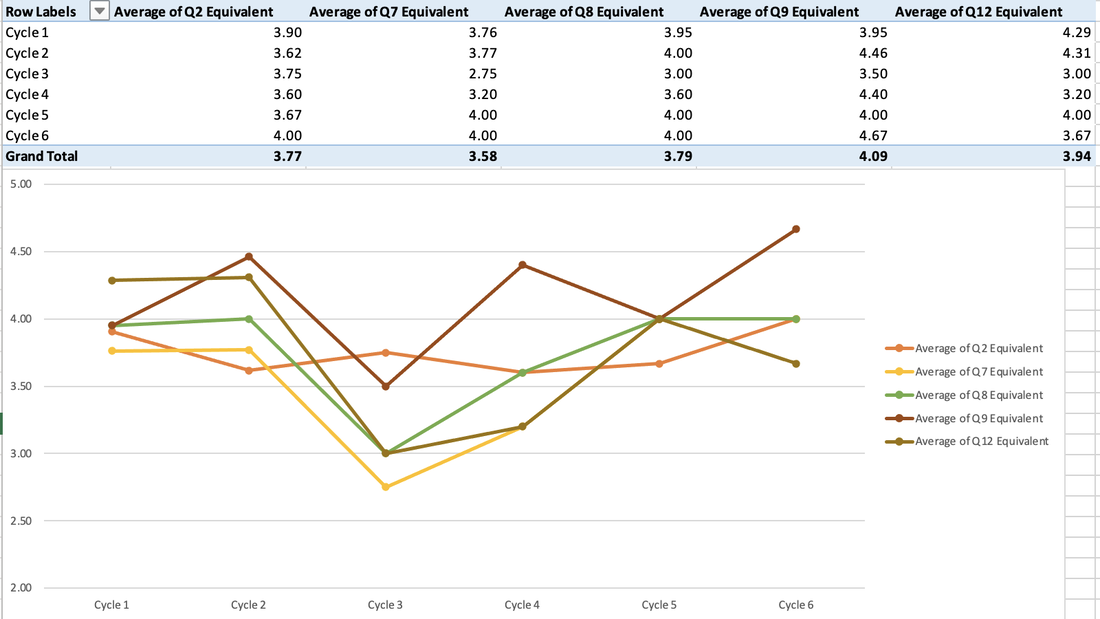|
For the past several years I have been working on integrating social and emotional learning (SEL) into my classroom. The inspiration for this came from a desire to include SEL in a real way as a part of regular classroom practice, no different from the content we teach. I completed a research paper entitled Social and Emotional Learning Self-assessment and its influence on Standards-based assessment. I also worked with on our school’s initial SEL scope and sequence team which informed my research as well as my own studies on the on the Interest Inventory, a project by the Aspire Survey folks. My approach is to provide students with self-assessment surveys based on SEL competencies once a school cycle (8 days at my current school) believing that regular, conscious thought about the competencies would improve overall performance and agency in the school. For the teacher, it helps me adjust my classroom aura to fit the general emotional state of my students. Students have a choice of six surveys. The surveys are anonymous and the feedback I receive comes in the form of pie and bar graphs. I write the surveys to be student friendly, that is, language is direct, and where appropriate, I remove pedagogical speak in place of teenager-speak. It should be noted I am approaching fifty so really it reads like dad jokes. The previous two school years I was making an attempt at keeping up but between all the regular responsibilities of teaching and the back-and-forth nature of online learning at our school, results were imprecise because of irregular data collection. However, this year I am happy to report that my performance has been much better, a result of dropping a few responsibilities in favour of doing this type of thing. The initial surveys were based on the IB Learner Profile and our school’s Student as a Learner Rubric; the latter similar to approaches to learning in the IB and other schools. Our school’s SEL scope and sequence has evolved, and I have used it to make more surveys about global citizenship, personal agency and responsibility; and identity. I have also used these surveys with two classes who participate in buddy classes with elementary school classmates. You can find a Word document with the questions I used and the original literature review at the bottom of this post. So now what? I am hesitant to say that has improved student learning, although I believe it has. My hesitation comes from the facts that, every student cohort is different, and I do believe that I have two very good cohorts at present. Also, nothing is new about the units I am teaching. I have been teaching them for four years now and reaching that Zen point where I know what’s happening and can adjust on the fly. Finally, I have not been keeping scientific data on any of this. Nonetheless, I stand by the assertion that it has improved student learning at the very least because it creates rapport between the students and I. This has been held up by psychologists smarter and more focused than I. So, the second semester has already begun and since this year school things seem to be working with the self-assessment survey approach I am going to take the next step. Fortunately, fate has provided just such an opportunity. Working with our school’s form and data guy, the fabulous Tony Fu I have been able to chart average response on several questions from the Myself and My Environment survey. You’ll notice a dip near cycle three. I thought to myself “What could be happening?” and so approached our school’s SEL counselors for some input. We discussed possibilities and reasons and looked at the calendar, but the strongest suggestion was to ask the students themselves, so I did. You can see their reasons to the right of the data. In general, lots of work inside school and lots of additional work related to but not a part of regular school. Little time for rest and enjoyment with friends, and the political climate. My school is in China and this coincided with the protests, lockdown, and the relationship between the USA and China (many of our students are Americans.) Our school calendar is approaching another such period. For IBDP students, mock exams and then exams, college acceptances, and final external assessments. For these students as well as the others we are entering a transition period. Including graduation, moving to new grades, some students leaving this community, teachers moving on (myself included,) and the new sports season is in full swing. Therefore, my approach will be to provide more opportunities for students to interact with one another in the classroom. We also have a new iteration of the buddy class coming up! Soliciting conversations with students about their work loads, and their experiences at tournaments (here’s hoping we win some,) giving them opportunities to do some low-stakes art fun, and taking them outside. As for the latter, I have no idea how I will work it into my lessons, but I’ll think of something and I am open to suggestions. What I am hoping to find is that there is a less of a dip mid-late March. I’ll report back on my Twitter at the least and hopefully here too. Check in again and feel free to use and adjust and distribute the surveys as you see fit. Don’t forget to cite your source – Mr. Allen is Cool dot com.
0 Comments
Leave a Reply. |
AuthorGreetings all! Here are some blog posts about nifty teaching things. ArchivesCategories |
|||||||||||||||||||||||||||||||||||




 RSS Feed
RSS Feed